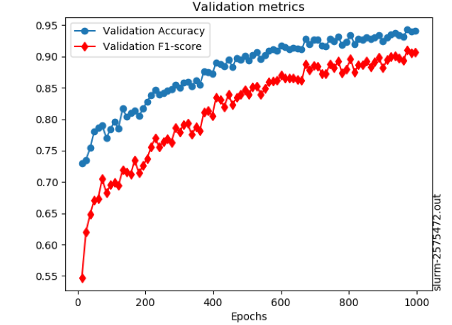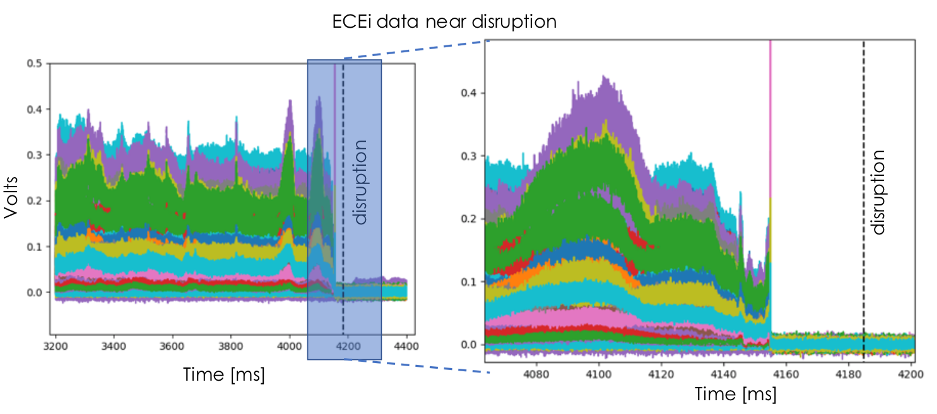Speaker
Description
Using modern deep neural network architectures, accurate disruption predictions on the DIII-D tokamak are made possible with the raw data from a single, high temporal resolution diagnostic which contains multi-scale, multi-physics sequences of events. This work illuminates a path forward to meet the disruption prediction requirements of devices such as ITER by using raw diagnostic data containing rich physics information without having to hand-craft features from these complex datasets generated by multiple tokamak diagnostics.
Excellent time-slice disruption prediction performance of 94% accuracy, and an F1-score of 91% (a metric indicating low false positives and false negatives rates) [Churchill2019] is achieved using a neural network architecture for multi-scale time-series, the Temporal Convolutional Network (TCN) [Bai2018] (see Fig. 1). This builds on other work using machine learning for disruption prediction [Kates-Harbeck2019, Rea2018, Ferreira2018], but in our case we show accurate performance training exclusively on a diagnostic previously unused due to its high sampling rate: the Electron Cyclotron Emission imaging (ECEi) diagnostic [Tobias2010] (see Fig. 2). The TCN is trained on a cluster of 16 GPUs over 2 days, on a subset of the available data, suggesting the need to incorporate High Performance Computing (HPC) resources to achieve the most accurate results.

These neural network disruption predictions were designed to be sensitive to pre-disruption markers up to 600ms before a disruption, giving sufficient time on DIII-D to avoid, not just mitigate, the disruption. This can then be tremendously beneficial as an accurate predictor for use in control systems to actively modify plasma actuators for avoiding disruptions. The TCN architecture can be adjusted and expanded depending on the required time sequence sensitivity, to adapt to newer machines, or different ranges of timescales.
The ECEi diagnostic is particularly well suited for disruption predictions due to its sensitivity to multiple time- and spatial-scales. There are a number of different root causes for disruptions, including edge radiation, too high density, and MHD instabilities [Boozer2012]. ECEi systems acquire data at such a high sampling rate (1 MHz) and spatial resolution ($k_\theta$ up to 2.1 cm-1) under ideal conditions that well-behaved signals span spatiotemporal scales to reflect the dynamics of turbulent fluctuations, Alfvén eigenmodes, tearing modes, sawteeth, ELMs, and other potential pre-disruption markers. Non-ideal conditions also impact the signal in ways that can be difficult for a human diagnostician to interpret, but are rich in information. For example, a sudden loss of signal can be the result of density cutoff. Alternatively, a sudden spike in signal can be the result of a non-thermal electron distribution. A wide range of other conditions can impact the signal, producing fluctuations or other features that machine learning techniques might become sensitive to, even when the human data analyst finds them to be troublesome or ambiguous. By using raw, un-processed ECEi data, we make full use of all these signal features.

These deep learning techniques show promise to greatly enhance the current machine learning worldwide effort being done on disruption predictions, one of the most pressing issues for the success of the tokamak concept. They open up the possibility of expanding the number and types of diagnostics used in disruption predictions, accurately including many different physics processes in these predictions. In the future, the correlations between channels and diagnostics that these networks learn on one machine can potentially be transferred and fine-tuned for a newer machine, requiring much less data from the newer machine then needed to originally train the models.
This work was supported in part by the US Department of Energy under AC02-09CH11466, DE-FC02-04ER54698, and FG02-99ER54531
[Churchill2019] R.M. Churchill, the DIII-D team, 2nd Workshop on Machine Learning and the Physical Sciences (NeurIPS 2019), arXiv:1911.00149
[Bai2018] S. Bai, et al., arXiv:1803.01271
[Kates-Harbeck2019] J. Kates-Harbeck, A. Svyatkovskiy, W. Tang, Nature 568 (2019) 526–531.
[Rea2018] C. Rea, R.S. Granetz, Fusion Sci. Technol. (2018) 1–12.
[Ferreira2018] D.R. Ferreira, ArXiv E-Prints ArXiv:1811.00333 (2018).
[Tobias2010] B. Tobias, et al., Rev. Phys. Instrum., 81 (10) (2010) 10D928
[Boozer2012] A. Boozer, Phys. Plasmas, 19 (5) (2012) 058101.
| Affiliation | Princeton Plasma Physics Laboratory |
|---|---|
| Country or International Organization | United States |
